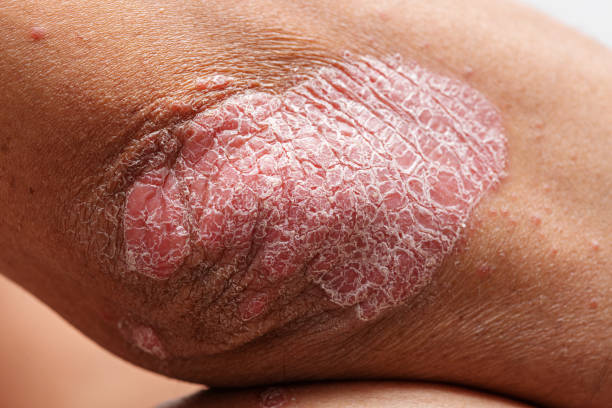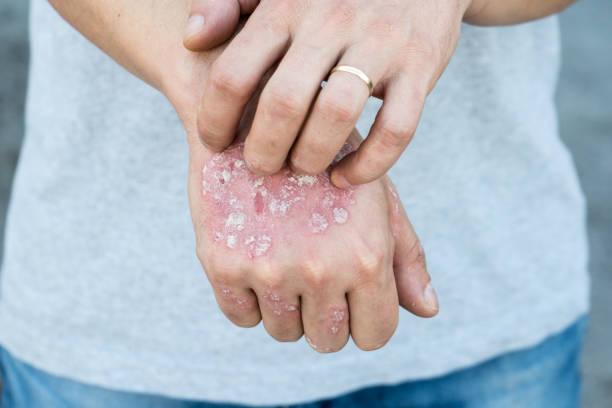Psoriasis is a chronic, immune-mediated skin condition characterized by rapid turnover of epidermal cells, which leads to thick, red plaques topped with silvery scales.
What is Psoriasis?
Psoriasis is a chronic autoimmune skin disorder driven by dysregulated immune responses that accelerate skin cell turnover. Normally,keratinocytesmature and shed over about a month, but in psoriasis this cycle compresses into days, causing thickened, silvery scales atop red, inflamed plaques. The underlying mechanism involves interplay between dendritic cells, T lymphocytes and keratinocytes, with cytokines such as tumor necrosis factor-alpha, interleukin-23 and interleukin-17 fueling a self-perpetuating loop of inflammation and hyperproliferation. Plaque psoriasis is the most common form, affecting roughly 80% of patients, but variants such as guttate, pustular, inverse and erythrodermic psoriasis can alter lesion morphology, distribution and severity. Globally,psoriasisaffects 2–3% of the population and often coexists with psoriatic arthritis, metabolic syndrome and cardiovascular disease, compounding overall health risks. Patients commonly experience intense itching, burning and joint stiffness, and the visible nature of lesions can provoke significant psychological distress. Although no cure exists, treatments spanning topical therapies, phototherapy and targeted biologics that inhibit specific immune mediators can dramatically reduce lesion severity. With early diagnosis and a personalized treatment plan, many individuals achieve clearance, improved function and quality of life.

What are the signs & symptoms of Psoriasis?
Psoriasis manifests through a constellation of dermatological signs and symptoms that can vary in intensity and morphology. The hallmark sign is sharply demarcated, erythematous plaques covered by silvery-white scales, most commonly appearing on extensor surfaces such as elbows, knees, scalp and lower back. These lesions often present bilaterally and symmetrically. Patients frequently report pruritus, burning or stinging sensations localized to affected areas, which may exacerbate scaling and fissuring when scratched.
In plaque psoriasis, the skin can crack and bleed, particularly on weight-bearing sites. Nail involvement occurs in up to half of individuals, characterized by pitting, oil-drop discoloration, onycholysis and subungual hyperkeratosis.
Guttate psoriasis, often triggered by streptococcal infections, presents as multiple small, drop-like lesions on the trunk and limbs.
Pustular variants exhibit sterile pustules on erythematous bases, while inverse psoriasis targets intertriginous zones such as axillae and groin, where lesions appear smooth, red and non-scaly.
Erythrodermic psoriasis can involve almost the entire body surface, causing widespread redness and desquamation, often accompanied by systemic symptoms like fever and malaise.
Joint symptoms, including stiffness, swelling and pain, may signify psoriatic arthritis. The fluctuating nature of these symptoms—with periods of remission and flare-ups—underscores the chronicity of psoriasis and its impact on quality of life.

Which parts of the body does psoriasis usually affect?
Psoriasis most often erupts on areas subjected to repeated friction, trauma or high immune surveillance, but it can appear virtually anywhere on the skin. The classic plaque form favors extensor surfaces—especially the elbows and knees—where thick, well-defined red patches are topped by silvery scales. The scalp is another prime location, with lesions creeping along the hairline, behind the ears and into the nape, often masquerading as stubborn dandruff. The lower back, sacral region and gluteal cleft frequently bear plaque or inverse psoriasis, while the umbilicus can harbor stubborn patches that resist topical treatments. Inverse psoriasis thrives within skin folds—armpits, under the breasts, groin creases and intergluteal areas—where warmth and moisture create a smooth, red but less scaly presentation. Guttate psoriasis typically covers the trunk and proximal limbs with hundreds of tiny “drop-like” papules following streptococcal throat infections. Pustular variants often localize to palms and soles (palmoplantar pustulosis), producing painful, sterile pustules on erythematous bases. Nail involvement—from pitting and oil-drop discoloration to onycholysis—is common, signaling potential psoriatic arthritis that targets joints of hands, feet, spine and sacroiliac region. In its most severe erythrodermic form, psoriasis can engulf nearly the entire body surface, disrupting barrier function and risking systemic complications. This diverse distribution underscores the need for a tailored treatment strategy that considers each patient’s unique pattern of involvement.

What are the types of Psoriasis?
Psoriasis encompasses several clinical variants, each distinguished by unique lesion morphology, distribution and severity.
The most common form, plaque psoriasis, accounts for about 80–90 percent of cases and presents as well-demarcated, erythematous plaques topped with thick, silvery scales, typically on the elbows, knees, scalp and lower back.
Guttate psoriasis often emerges in children or young adults following streptococcal pharyngitis, erupting as dozens to hundreds of small, drop-shaped papules on the trunk and proximal limbs that can resolve spontaneously or evolve into chronic plaque disease.
Inverse psoriasis, also known as flexural or intertriginous psoriasis, appears within skin folds—such as the groin, axillae and under the breasts—where plaques are smooth, red and less scaly due to the moist environment.
Pustular psoriasis manifests as sterile pustules on erythematous skin and can be localized to the palms and soles (palmoplantar pustulosis) or widespread, sometimes accompanied by systemic symptoms like fever and malaise.
How is Psoriasis treated?
Psoriasis treatment is multifaceted, spanning topical approaches, phototherapy, systemic medications, advanced biologics and supportive lifestyle measures.
For mild to moderate plaque psoriasis, first-line topical agents include corticosteroids, vitamin D analogues (calcipotriene, calcitriol), retinoids and calcineurin inhibitors (tacrolimus, pimecrolimus), which reduce inflammation and normalize keratinocyte proliferation. Emollients and barrier repair creams alleviate dryness and scaling.
For extensive or refractory disease, phototherapy with narrow-band ultraviolet B or psoralen plus UVA (PUVA) can suppress pathogenic T‐cell activity.
Systemic treatments such as methotrexate, cyclosporine and acitretin are reserved for severe cases, balancing efficacy with potential toxicity.
The advent of biologic agents, including tumor necrosis factor inhibitors (etanercept, infliximab, adalimumab), IL-12/23 blockers (ustekinumab) and IL-17 antagonists (secukinumab, ixekizumab), has revolutionized management by selectively targeting inflammatory pathways while sparing global immunity.
Conclusion
Psoriasis is far more than a surface condition—it’s a dynamic interplay of genetics, immune dysregulation and environmental triggers that manifests on skin, in joints and even within cardiovascular and metabolic systems. While its chronicity and visibility can feel relentless, modern care offers a spectrum of tools—from soothing topicals and targeted phototherapy to groundbreaking biologic therapies that interrupt specific inflammatory pathways. Yet true success hinges not just on clearing plaques, but on nurturing overall well-being: recognizing and managing stress, maintaining healthy weight, monitoring comorbidities and fostering strong partnerships with dermatologists, rheumatologists and primary care providers. Patient education and self-advocacy empower individuals to personalize treatment plans, anticipate flares and sustain long-term remission. By reframing psoriasis as a manageable, systemic condition rather than a mere cosmetic issue, we open the door to comprehensive strategies that restore comfort, confidence and quality of life.
Read More

